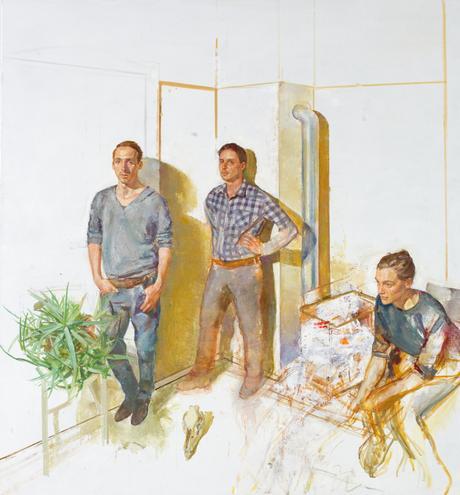
2014.05 (c) Steven Black (oil on canvas) – Courtesy Galerie Thomas Fuchs
Long before I met Steven Black, I came to know him indirectly, but in a strangely intimate way. I stayed in his Leipzig flat every time I visited that moody, gritty city, and encountered him through his freshly vacated rooms, his formidable multilingual library, his jungle of plants, his pantry, his coal ovens, his music, even his friends, but most of all his paintings. The paintings unobtrusively watched over my parallel life in Leipzig, the silent, contemplative faces observing intently, sunken in their own thoughts, impenetrable as the coarse paint in which they consist. I lived with them, communed with them over breakfast, worked among them. The walls absorbed them, reflecting the same dreamy blues and faded browns, the same peeling and crumbling textures.
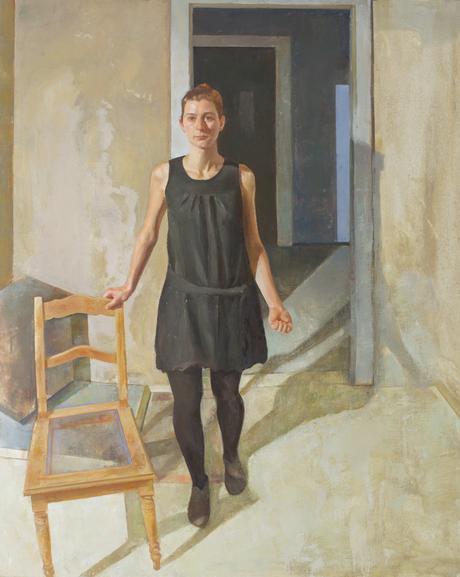
2014.04 (c) Steven Black (oil on canvas) – Courtesy Galerie Thomas Fuchs
The flat feels like a transplanted old Queenslander house, uprooted from a subtropical clime and deposited—as precarious as it would have been on its original wooden stilts—atop an East German apartment building. It seems ill-equipped for bleak German seasons, as though it were built to stay cool in warmer weather, its charmingly disintegrating and sprawling wooden interior always chilled despite the coal ovens we have to stoke and feed around the clock. Eventually I learn that it was Black himself who was the transplant, and that he, like me, called Brisbane home, once.
Quiet days dawn in that flat, the sunlight trickling weakly through the mist. Black’s books pepper every corner of the house—German and French philosophers, yellowed poetry books and art books heavy with pictures. The stacks of CDs reveal a penchant for classical music. We are captivated by Pablo Casals, the throbbing cello filling the flat and becoming our work anthem. Ezra Pound and Max Klinger accompany us to breakfast under a crumbling sky-blue wall whose cracks look like clouds; Wittgenstein hovers by my computer; Deleuze taunts us and Velázquez lulls us to sleep.
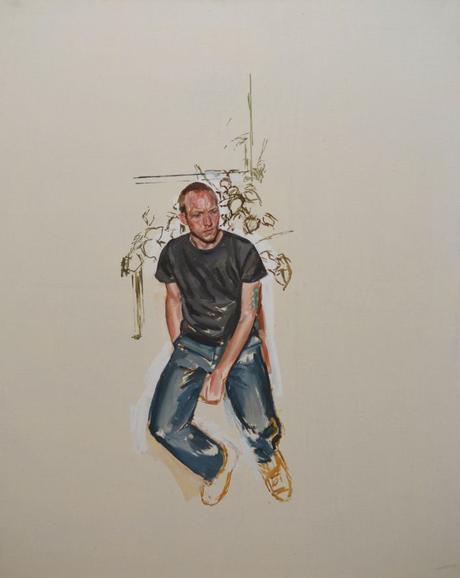
2007.03 (c) Steven Black (oil on canvas) – Courtesy Galerie Thomas Fuchs
When I finally meet Black, I’ve already had quite an introduction. He suddenly returns from Australia, simultaneously languid and bustling. He has much to do, and his restless energy permeates the flat with a new urgency; his radio and podcasts and lectures fill the cool air with busy chatter. But he is easily diverted, and has a special knack for turning any conversation into a deep, lingering discussion. He is always brimming with insights and eager to share them, insights that have been subjected to long and careful consideration.
His friends come over unexpectedly, drifting in and out as they seem to in his paintings. I began to meet these characters that I had lived among, and to realize that these paintings are every bit real life. Many of the silent thinkers prove to be other Leipzig artists: Stefan Guggisberg, Johannes Rochhausen, Sebastian Stumpf, Timm Rautert. They share homely meals, or sit and talk, seeming every bit at home in this flat as Black does. I realize we, too, have been welcomed into this comfortable domesticity when Black assures an impromptu guest, ‘Sie wohnen hier, ungefähr, du kannst sie ignorieren.’ (‘They live here, more or less, you can ignore them.’) I glance up at the paintings and they mirror the life of this flat: still, quiet people, casually dressed, slouching and reflecting, or standing and gazing distractedly, a gentle stream of conversation or an audio book or Pablo Casals washing over them. The pictures fix that lingering mood, that tone of probing the deeper things in life. A meditative guest might find themselves the balancing element in a heretofore unresolved painting, as what starts as a discussion ends as the visual solution Black has been looking for.
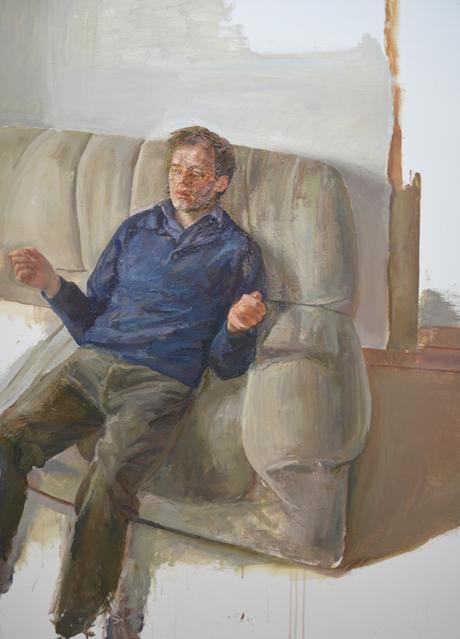
2012.07 (c) Steven Black (oil on canvas) – Courtesy Galerie Thomas Fuchs
The paintings are drawn up with runny Indian yellow lines that trickle down the canvas. It’s a warm and sunny and earthy beginning. The drawing starts out somewhat rigid, but leaky, as Black positions his protagonists, establishes perspective, digs into the corners of the room. The angles dominate: the intersections of walls and doorframes and pipes of coal ovens and tubular chairs. The organic beings that emerge from the underpainting begin to come alive as the layers of eggshell blues and pale browns and ochres and transparent yellows pile on, concentrated at these visually inviting junctures, the angular grid of the room comparatively receding. Sometimes the paint converges to a frenzied climax at the face, which can be smushed beyond recognition: naturalism gives way to paint itself—to thick, abusive paint, growing like some leprous disease, pocking the face with actual shadows in its unexpected three-dimensionality. Such faces seem to suck inwards like black holes, bubbling with the mental fury of the otherwise obedient stillness of the sitter.

2009.03 (c) Steven Black (oil on canvas) – Courtesy Galerie Thomas Fuchs
Seeing the portraits among the balcony landscapes and stairway paintings, a sudden aptness, a smooth continuity, emerges. The cool views outside carry the same contemplative mood of the stark interiors. There is yet something introspective about these outward-turned gazes. Black works intuitively, but also very visually. He is not a slave to what he sees, but he feeds on what he sees. Each painting is a fresh encounter with his environment—inside or outside—a meditation upon it. The view is usually comfortably intimate and familiar, but observed afresh every time.
And yet I feel it is not quite correct to say that Black simply paints his house. For he only ever seems to hint at it, to mark in the ghost of its skeleton. He strips it of the little treasures that move about the house and presents it as bare and indeterminate. Sometimes the setting is not so much the room as the ill-defined transition between rooms—as in the portrait where a woman stands in the doorway, catching the sun, with the wide, shadowy hallway gaping behind her and prying open the space, and beyond that another doorway cuts into the inviting blueness. The transitory setting could be somehow destabilising. But here is the thing: when you know the house—as she does, as the other sitters do, as the comers-and-goers do—you recognize the distant kitchen immediately, you situate her in the old familiar flat instantly. More than the appearance of the flat, the intricacies of it, Black captures the sense of moving about in the flat, of occupying different corners, of coming and going; the lived-in-ness of every pocket of it.
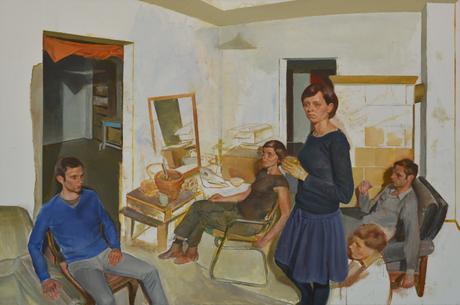
2012.06 (c) Steven Black (oil on canvas) – Courtesy Galerie Thomas Fuchs
Black, characteristically irreverent, remarks, ‘The gallery is the last place my paintings should be seen.’ I think I know what he means. They trade on intimacy and familiarity, on the home he has woven with the movements of his friends. His paintings should be lived among, in their native setting.
Nevertheless, you can see Steven Black’s paintings in Stuttgart early next year:
Galerie Thomas Fuchs
Reinsburgstrasse 68A
70178 Stuttgart
Deutschland
20.01. – 11.03.2017
Vernissage: Freitag, 20.01.2017, 18 bis 23 Uhr

